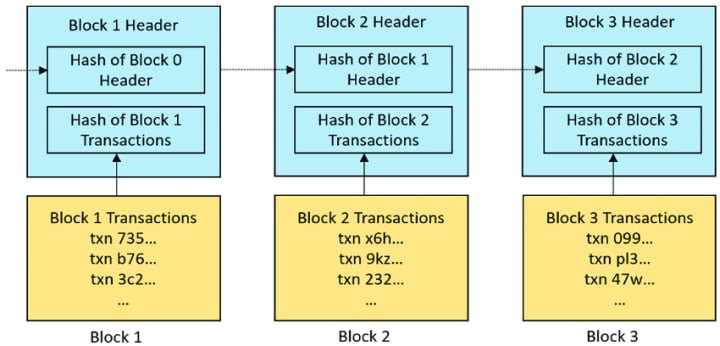What is Blockchain?
Blockchain in Simple Terms.

Blockchain is a data storage and retrieval system with distributed ledger technology (DLT). Bitcoin offered the first iteration of Blockchain as a peer-to-peer transaction. It's a ledger or database in which earlier records can't be changed. The data on blockchain is unchangeable. The data is spread over numerous computers rather than being stored on a single server or computer. Nodes are the names given to these computers. It is nearly tough to hack because it is immutable and saved across several machines. It eliminates the possibility of a single point of failure.
Although blockchain is classified as a database, it differs significantly from traditional databases in terms of how it stores and handles data. Blockchain stores data in blocks that are digitally chained together, rather than rows, columns, tables, and files, as traditional databases do.
Shares Ledger
In Blockchain Ledger is an Append only distributed database shared across the network. With data is Immutable and cannot be changed and the transactions are recorded once.
Smart Contracts
Smart contracts are the programs which runs on top of blockchain network.It is like a class in the normal programming terms
There are three basic concepts that govern how Blockchain works.
- Chaining
- Consensus
- Replication
Chaining

Each block, as seen in the diagram above, comprises transactions as well as a block Hash code. A fixed-length hash output is generated from the transactions in a block and added to the block header. Every subsequent valid block must include the previous block header's hash output. Every valid block is linked to the ones before it by the hash of the previous block header. As a result, a chain of blocks (blockchain) is formed by connecting each block to the preceding ones.
Consensus
Permissionless Blockchain works on a vast scale with millions of servers and is decentralised. This is a set of rules that determines the legitimacy of transactions carried out by the network's various Nodes. To ensure that all transactions are valid and that all participants agree on the consensus, these publicly accessible ledgers require an efficient, real-time infrastructure. There are Three types of Mechanisms widely followed in Blockchain.
- Proof of Work (PoW)
- Proof of Stake (PoS)
- Proof of Elapsed Time (PoET)
Proof of Work
PoW Consensus is used by several cryptos, notably Bitcoin. Hashes are used to identify tampering; when a string of value is passed to a hash function, it generates a Hash Value. Even if the string's little value is changed, the Hash becomes unrecognisable. The length of the Hash will remain constant regardless of the quantity of the data. Hash is a one-way function, which means it can't be used to get the original data back.
Miners compete to solve the PoW mathematical puzzle (the solution is a proper hash), confirm and produce blocks, and receive a reward for their efforts. This method eliminates the requirement for a third party.
Proof of work requires a computer to perform hashing functions at random until it generates an output with the three leading zeroes. Consider a block with a hash of 000hdyrfebchtykeysh8eddcaf078f12c69a439dde34dkg78e2v5g8hdgty56ew, 100 transactions, and a value of 100 Bitcoin. The hash code of earlier blocks would also be included in the block. If we make tiny changes to any of the transactions, the Hash code will change, and the following block will refuse to accept them.
Proof of Stake
Proof of Stake is the next consensus mechanism used by certain Cryptos. To become a validator, users must stake or commit enough coin. In Ethereum, it's 32 ETH. In real-world scenarios, many people compete, and validators are randomly assigned to produce blocks and are responsible for certifying the blocks created by other validators.
The stake of the user is also used to incentivize positive validator activity. For example, a user can lose a portion of their share if they go offline (fail to validate) or lose their entire investment if they engage in willful collusion.
Proof of Elapsed Time
Permissioned Blockchains employ Proof of Elapsed Time. On each node in the network, a timer will be running. This randomly generated validator ensures that everyone has the opportunity to earn money.
On a blockchain network, the algorithm decides mining rights and block winners using a randomly generated elapsed time. The PoET algorithm improves transparency by ensuring lottery results are verifiable by external participants by running a trustworthy code in a safe environment.
When a node seeks to join the network, it must do a particular verification. Intel's Software Guard Extension (SGX) technology, which was initially launched in 2015, is used to perform this verification. It generates an attestation for a piece of code and secures it against outside access.
Replication
Blockchain instantly replicate data in multiple nodes, our data will be present in many servers. If any of the servers crash the data will be available and systems will run as usual.
Conclusion
Apart from digital currencies, blockchains are employed in a variety of industries in the real world. Blockchain is being tested across a variety of areas, including supply chain, health care, digital identity, and many more. Understanding the fundamentals is the first step in using and developing new technology.
About the Creator
Bala subramanian
Co-Founder and CTO - Claritaz TechLabs. Combines the best of both worlds: technological and entrepreneurial.
Works with start-ups, guiding them through the technological process while they take tiny steps and till they become Sustainable.
Enjoyed the story? Support the Creator.
Subscribe for free to receive all their stories in your feed. You could also pledge your support or give them a one-off tip, letting them know you appreciate their work.





Comments
There are no comments for this story
Be the first to respond and start the conversation.